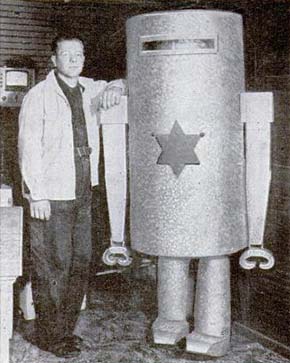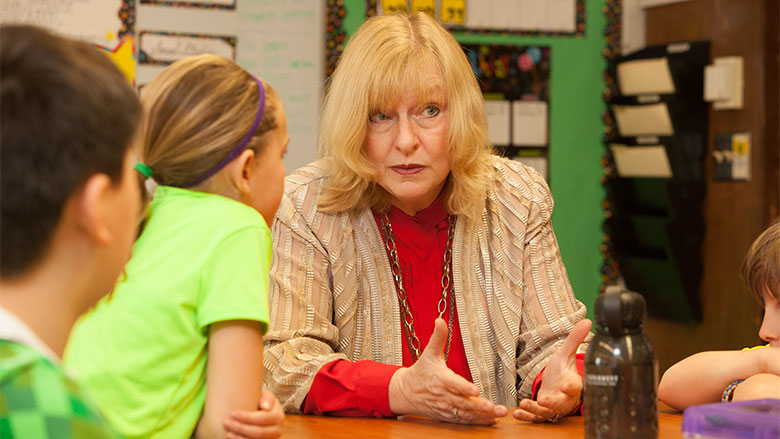Archive for July, 2015
Fiction to fact: Researchers advancing artificial intelligence

Younger’s inspiration — his dad, Reat — was featured in Popular Mechanics in 1948 with a robot he built.
Science fiction writers from Issac Asimov to Roger Zelanzny have written about the coming age of robots and artificial intelligence for many years. Generations of viewers raised on “Star Trek,” “Star Wars” and even “The Jetsons” grew up expecting our world to be eventually populated by intelligent machines doing many of the mundane tasks for us.
Believe it or not, two Missouri State researchers are actively working to make that vision a reality. Dr. A. Steven Younger, applied science and engineering research professor, and Dr. Emmett Redd, physics, astronomy and materials science professor, are directing their research efforts toward developing machines with more brain-like intelligence and capabilities.
Younger and Redd believe that, despite the capabilities of modern computers, their research could contribute to the development of an advanced machine with a knack for common sense and the ability to learn well beyond the parameters of its programming.

Pursuing brain-like flexibility
Research for this project is being completed in conjunction with Dr. Hava Siegelmann, professor of computer science at the University of Massachusetts–Amherst, with financial assistance from the National Science Foundation. Siegelmann’s work focuses on neural networks, circuits designed to mimic neurons connected by synapses. The system could theoretically result in incredible computing power. Redd and Younger were aware of her work before realizing their research was moving in the same direction.
“We are trying to build a machine that can make computations a standard Turing machine (the model for a standard digital computer) can’t. We are particularly interested in machines that have properties that are important for more brain-like, intelligent capabilities: learning, adaptability, pattern-recognition robustness and flexibility.” — Dr. Steve Younger
The approach the researchers have taken involves a chaotic system, which is very sensitive to small changes. This analog system can react to bigger and smaller changes, which can feedback to cause other bigger and smaller changes. The system, therefore, becomes driven by unpredictable and extremely variable noise, which Younger and Redd are convinced creates the less rigid approach of a chaotic-neural network and is more likely to lead to more brain-like intelligence.

Differences between analog and digital
Most people know that digital is a binary system based on combinations of “1” and “0.” An analog system, however, includes all the space between. This approach sacrifices the ultra-precision of digital computation for a more complex and flexible process. The random nature of an analog process can lead to mistakes, which just might be a good thing, since the machines could learn from these mistakes and be less likely to make the same errors later.
Redd elaborates: “A car can’t fly; an airplane can, although they share many of the same components. We’re trying to build components and designs that allow us to go beyond what the Turing machine offers.”
In addition to the inherent complexity of a super-Turing machine, there are also size and power advantages. “We are reaching size and power limitations of digital computers,” Redd said.
“Think about Google’s search computers; they aren’t as powerful as the human brain and yet the brain operates on far less power.” — Dr. Emmett Redd
The practical applications from this research are potentially vast. “Probably the biggest application would be pattern recognition and robotics,” said Younger. “We can see where there could be an analog computer that could talk together and work together with a digital computer, because there are several things that digital computers are so good at.”
Why the weekly spelling test doesn’t stick
During his third grade year, Masterson noticed her son was still having a hard time making his marks on his spelling tests despite extra study time. Again, she spoke with his teacher and received the same response as the teacher from the year before: “Oh that’s normal. He’ll learn.”
Masterson refused to accept the idea that individuals could not improve a skill.
She dropped the subject for a second time and continued to help him study at home. As he later progressed in the fourth grade, his teacher noted his poor spelling skills but said that nothing could be done about it because, “people are either good at spelling or they aren’t.” As a speech-language pathologist, Masterson refused to accept the idea that individuals could not improve a skill. She had indeed observed her son’s struggle to spell words, but she had also spotted something else: He was a very strong reader despite his poor spelling skills.
Why was this? This question motivated Masterson for the next 20 years as she researched literacy development in young children. Her findings suggested that the way in which we teach our children to spell may be wrong.
What is spelling awareness?
“How were we taught to spell? Most of us were given a list of words on Monday that we had to study at home, memorize really, throughout the week and then we took a test on Friday,” said Masterson. “What we’ve initially found in our research is that spelling isn’t dependent on memorizing. It may work for the Friday test, but kids will go back to spelling the words the way they did after that.”
Masterson found that in order to learn how to spell, you need three things: sound awareness, meaning awareness and spelling pattern awareness.
Using the word “burned” as an example, the reader must know that “burned” has four sounds, and this is sound awareness. They must also know that “ur” sound can be spelled a variety of ways, such as “-er” or “-ur,” and this is spelling pattern awareness. But what about meaning awareness?
“How were we taught to spell? Most of us were given a list of words on Monday that we had to study at home, memorize really, throughout the week and then we took a test on Friday.” — Dr. Julie Masterson
“When you hear the word ‘burned’ the last two sounds in that word are the ‘n” and the ‘d’ sounds,” said Masterson. “Well because you know that the word refers to an event that occurred in the past, you know not to just end that word with a ‘d;’ you know to spell it with an ‘-ed.’”
After readers have successfully mastered all three features of spelling a word or set of words, they must develop automaticity. Automaticity is the ability to know how a word is spelled without having to go through its three features. It involves having clear “mental pictures” of words and allows a reader to instantly recognize a word or a writer to automatically spell a word.

Improving both spelling and reading
In order to define exactly what it is kids need to learn and how best to teach them, Masterson designed tailored interventions based on how children spell various types of words. She and her collaborators (including many MSU students) developed software to analyze spellings and indicate goals and methods for treatment as well as a metric to monitor student progress. The team conducted treatment studies and found that the children’s spelling did get better, but their reading improved to an even greater extent. Improvement in reading is particularly important in an era of school accountability.
With this metric, they’ve been able to do several group comparisons on children from various backgrounds, including kids of aboriginal descent in Australia and those who are African American versus not African American. They also tested children who were living with certain conditions like speech disorders or deafness.
“People would have assumed that if you were deaf for a number of years, your spelling errors would be primarily due to a lack of awareness of sounds because you weren’t hearing them…Yes, some of them were, but a lot of them were just like errors in people who are hearing yet have failed to learn the necessary spelling features. The good news is that our tailored treatment can be used to help them learn what they need to learn.”
Lost? Here’s a map for early literacy development
 The three spelling features and more are discussed in Masterson’s newly-revised book “Beyond Baby Talk: From Speaking to Spelling: a Guide to Language and Literacy Development for Parents and Caregivers.” Co-authored with Dr. Kenn Apel and sponsored by the American Speech-Language-Hearing Association (ASHA), the book provides parents with the resources necessary to properly monitor their child’s development from infant to the third grade. Masterson had no intention of writing a book, but when she was approached by the executive director of ASHA she quickly saw the topic’s potential for a wider audience. Her expertise on the subject and second edition of the book led to her being featured in articles for NBC’s “Today Show” about how to tell the difference between normal developmental variation and potential disorders, gender differences in language development, and how to teach young children to be kind.
The three spelling features and more are discussed in Masterson’s newly-revised book “Beyond Baby Talk: From Speaking to Spelling: a Guide to Language and Literacy Development for Parents and Caregivers.” Co-authored with Dr. Kenn Apel and sponsored by the American Speech-Language-Hearing Association (ASHA), the book provides parents with the resources necessary to properly monitor their child’s development from infant to the third grade. Masterson had no intention of writing a book, but when she was approached by the executive director of ASHA she quickly saw the topic’s potential for a wider audience. Her expertise on the subject and second edition of the book led to her being featured in articles for NBC’s “Today Show” about how to tell the difference between normal developmental variation and potential disorders, gender differences in language development, and how to teach young children to be kind.
Metals move front and center to target cancer
“In our household was a jar of water at the table. In it was an old Czar Russian silver ruble at the bottom — a pure silver coin. That silver leeching slowly out in the solution provided pretty good sterilization of water.”
 The antimicrobial property of silver is one key to a current research project Gerasimchuk is conducting 30 years after receiving his first doctorate degree in Kiev, Ukraine. He is developing a set of compounds that, when added in a small amount to light-curable polymeric medical adhesives, could be used to properly set medical indwelling devices and prevent infections at those sites. This coating mixture, which is also water insoluble, light insensitive and thermally stable to withstand the rigors of medical and dental procedures, is patent pending and not available yet. Gerasimchuk envisions a day, though, when it will be used with pacemakers, joint replacements and in dental implants.
The antimicrobial property of silver is one key to a current research project Gerasimchuk is conducting 30 years after receiving his first doctorate degree in Kiev, Ukraine. He is developing a set of compounds that, when added in a small amount to light-curable polymeric medical adhesives, could be used to properly set medical indwelling devices and prevent infections at those sites. This coating mixture, which is also water insoluble, light insensitive and thermally stable to withstand the rigors of medical and dental procedures, is patent pending and not available yet. Gerasimchuk envisions a day, though, when it will be used with pacemakers, joint replacements and in dental implants.
“What we are hunting for is to make that interface between tissue and any indwelling device antimicrobial. Because what happens in many cases is that infection comes in place where the device is set, and we know what that means: The loss of productive lifetime, increased post-procedural rehabilitation and recovery time, pain and significant material cost needed to address the problem. ”
“The more I was doing this work, the more I realized how beautiful this group of molecules is.” — Dr. Nikolay Gerasimchuk
The common thread between each of Gerasimchuk’s research projects is a subclass of organic compounds that he discovered called cyanoximes. These compounds bind metal ions strongly and have many characteristics depending on what they’re bound to.
“The more I was doing this work, the more I realized how beautiful this group of molecules is,” he said. “I saw an opportunity to build a tinker toy, a Lego type approach, so we can keep one part of the molecule consistent and then add a huge variety of other parts to it to change the compounds’ properties such as solubility, bulkiness, color, etc.”
That’s exactly what he’s doing with his two other research projects, both of which also have medical applications.

Fighting cancer with palladium compounds
Many of the primary anticancer drugs are platinum based, Gerasimchuk explained, which poison every cell they encounter. These drugs work because cancer cells divide much faster than non-cancerous cells, and blocking that division cycle is one of the main tactics in the fight. But tumors build resistance to this type of drug. To improve the effectiveness of these drugs and alleviate side effects in cancer patients, Gerasimchuk is designing compounds structurally similar to these anticancer compounds and making them more water soluble by binding these substances to specifically designed cyanoximes.
He is also working to develop anticancer active compounds using cyanoximes with palladium, platinum’s neighbor on the periodic table.
“Palladium is much less toxic and much less expensive, so we are testing whether we will persistently see slightly better activity of our new palladium compounds compared to those with platinum. If so, then we can push for a new type of drug.”
Platinum compound used to find, fight cancer
 Approximately 15 years ago, a new scientific field was created called theranostics — a combination of therapy and diagnostics. It’s still being explored, and Gerasimchuk is contributing by designing and making platinum cyanoximes complexes to find tumors and ultimately act as anticancer agents.
Approximately 15 years ago, a new scientific field was created called theranostics — a combination of therapy and diagnostics. It’s still being explored, and Gerasimchuk is contributing by designing and making platinum cyanoximes complexes to find tumors and ultimately act as anticancer agents.
Visualize a stack of poker chips with platinum centers. The stacks are flexible and loosely connected by a thin thread down the center of the stack. Electrons move along the thread, and as they move, they can absorb light in visible region of spectrum and re-emit it in the near-infrared region.
“What we would like to do is to put these compounds inside of cells or tissue. Since they emit light at this very specific range of wavelengths (near-infrared), it comes through tissue without being absorbed,” he explained.
For this project, Gerasimchuk partnered with Dr. Mikhail Berezin from Washington Medical School’s department of radiology, who built a $1 million piece of equipment that allows scientists to view in the near-infrared range. Their work on this theranostics project was published in the January 2015 issue of the American Chemical Society’s journal, Inorganic Chemistry.
With Berezin’s equipment and the patent-pending new infrared emitters, doctors could diagnose and target cancer cells.
“Once the compound disassembles due to metabolic processes, it acts as an anticancer agent and kill cancer cells. That is a very cool application!”

